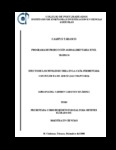Efecto de los niveles de urea en la caña fermentada con pulidura de arroz (Sacchapulido)
Abstract
Con el objetivo de encontrar el nivel de urea más adecuado, desde el punto de vista biológico y económico, que incremente la proteína verdadera (PV) en la fermentación en estado sólido (FES) del Sacchapulido, se realizó un experimento de tipo factorial (5 x 2), el primer factor llamado tratamientos (T) consistió de 5 niveles de urea (0, 0.5, 1.0, 1.5 y 2.0% para T1, T2, T3, T4 y T5, respectivamente), y el segundo factor consistió en dos tiempos de fermentación (0 y 24 h). Se utilizó un diseño completamente al azar con arreglo en parcelas divididas en tiempo con 6 repeticiones por tratamientos. El tallo de la caña se cosechó 24 h antes, se molió y se mezcló con 20% de pulidura de arroz, 4% pasta de soya, 0.3% de sulfato de amonio, 0.5% de minerales y urea, según tratamientos. Se pesó 200 g de muestra y se homogenizó, de estos, se utilizó 100 g para determinar los parámetros bromatológicos y fermentativos al inicio de la fermentación (0 h) y los 100 g restantes se depositó en frascos Roux y se dejó fermentar durante 24 h. El pH fue afectado (P<0.01) por el tiempo de fermentación y los niveles de urea (P<0.05), disminuyó a las 24 h, y alcanzó los mayores valores con la adición del 1.0, 1.5 y 2.0% de urea, sin diferencias entre ellos. El ácido láctico fue afectado por los niveles de urea (P<0.001), el incremento se obtuvo con la inclusión de 1.5 y 2.0%, sin diferencias entre ellos. La de MS disminuyó (P<0.001) las 24 h y no fue afectada por los niveles de urea. La PB se incrementó (P<0.001) a las 24 h y fue afectado (P<0.001) por los niveles de urea, el mayor valor se obtuvo con la adición del 2% de urea (18%). La FDN y FDA se incrementaron (P<0.01) a las 24 h y no fueron afectadas por los niveles de urea. Hubo interacción significativa para la PV (P<0.01), Con el 0 % de urea, no hubo diferencias entre 0 y 24 h, y al adicionar urea, se obtuvieron valores mayores a las 24 h, con la adición de 1.0, 1.5 y 2.0% de urea, sin diferencias entre ellos. Se concluye que en la fermentación en estado sólido del Sacchapulido se le debe incluir 1% de urea.______With the objective of finding the most appropriate level of urea, from the biological and economical point of view that increases the true protein in the fermentation in solid state (FSS) of the Sacchapulido, the experiment was carried out as a factorial type (5 x 2).The first factor to be considered was treatments (T) that consisted of 5 levels of urea. The second factor consisted in two time periods of fermentation (0 and 24 h). A design was used totally at random with an arrangement in parcels divided in time with 6 repetitions for treatments. The shaft of the cane was harvested 24 hours before it was milled and it was mixed with 20% polished rice, 4% soya paste, 0.3% of ammonium sulfate, 0.5% of minerals and urea, according to the treatments. 200 g of the sample were weighed and homogenized. Of these, 100 g were used to determine the bromatological and fermentative parameters at the beginning of fermentation (0 h). The 100 remaining g were deposited in Roux flasks and were allowed to ferment for 24 hours. The pH was affected (P <0.01) during the time of fermentation and with the levels of urea (P <0.05). It diminished after 24 hours and reached the greatest values with the addition of the 1.0, 1.5 and 2.0% of urea, without differences among them. The concentration of lactic acid was also affected by the levels of urea (P <0.001). The biggest values were obtained with the inclusion of 1.5 and 2.0%, without differences among them. The quantity of MS diminished (P <0.001) in 2.2 units percentiles after 24 hours and was not affected by the levels of urea. The PB increased (P <0.001) by 0.8 units percentiles after 24 hours and was affected (P <0.001) by the levels of urea. The greatest value was obtained with the addition of 2% of urea (18%). The FDN and FDA increased (P <0.01) after 24 hours and were not affected by the levels of urea. There was significant interaction for the PV (P <0.01), when comparing the times of fermentation. In the treatment without urea, there were no differences between 0 and 24 hours. When urea was added, in all the treatments, the greatest values were obtained after 24 hours; the biggest values were reached with the addition of 1.0, 1.5 and 2.0% of urea, without differences among them. One can conclude that in fermentation of Sacchapulido in the solid state, 1% of urea should be included.
Collections
- Tesis MC, MT, MP y DC [284]

